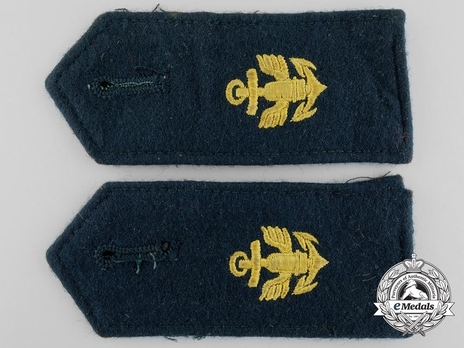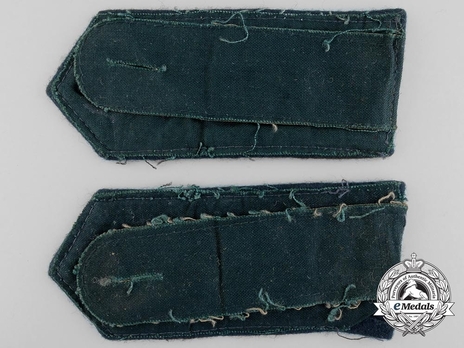Kriegsmarine Matrose Shoulder Boards
SKU: 21.GOR.03.02.02.06.001
Estimated market value:


Estimated market value:
Attributes
History
The headgear, uniforms, and insignia worn by members of the Kriegsmarine were based upon the designs utilized by the Kaiserliche Marine and the Reichsmarine. The official regulations governing the uniforms of the Reichsmarine were issued on April 5, 1921, and they were embraced, with a few alterations, as the Kriegsmarine uniforms in 1935.
The Kriegsmarine shoulder boards were manufactured in three distinct styles, sew-in, slip-on, and pass-through.
These Shoulder Boards were worn by enlisted men within the coastal artillery, which include personnel with the rank of Obermaat, Maat, and Matrose, as well as Cadets and Officer Candidates. The boards were worn on the outer garments of the field-grey uniform and the brown tropical uniform.
These shoulder boards were composed of badge cloth or basic cloth, a sewn seam or gold-coloured gilt wire tress, a detachable or sewn-in tongue, and rank insignia. The length of the boards varies depending on the size of the wearer.
The boards manufactured prior to the Second World War generally feature badge cloth, while those that were produced during the war largely have basic cloth that is field-grey for the field-grey uniform, and brown for the tropical uniform.
The shoulder boards of Obermaat ranked personnel have a gold-coloured tress boarder along all outer edges for the field-grey uniform, or a cornflower-blue ribbon trim for the tropical uniform.
The shoulder boards of Maat ranked personnel have a gold-coloured tress boarder along three edges, not the bottom edge, for the field-grey uniform. The same configuration was used for the tropical uniform, but with a cornflower-blue ribbon trim.
The shoulder boards of Matrose ranked personnel have a sewn seam border on the shoulder board. As well. These boards could also be worn by Cadets, who were differentiated by two rows of gold-coloured tress at the bottom edge of the board. The boards worn by cadets do not have unit insignia.
Unit insignia were worn the field-grey uniform. Prior to the Second World War they feature both numbers and letters, while those worn during the war only feature symbols/letters. The unit insignia worn by enlisted personnel, from Junior Non-Commissioned Officers to Cadets, was composed of machine-embroidered golden-yellow coloured thread. The thread itself may be composed of a variety of materials, including cotton, artificial silk, or wool.
Known unit insignia includes:
Aircraft Reporting Detachments: This unit insignia was instituted in April 1938, and it features a surmounting detachment number above two crossed, unfouled anchors with four lightning bolts.
Coastal Artillery Battalions: There are three main versions of the Coastal Artillery Battalions unit insignia. The battalion number (Roman numbers) above two crossed, unfouled anchors until 1939; from mid-March 1939-September 1939 one unfouled anchor with a flaming, winged artillery shell all surmounted by the battalion number (Arabic numbers); during the Second World War the surmounting battalion number is no longer used.
Non-Commissioned Officer Instruction Battalions: There are three main versions of the Non-Commissioned Officer Instruction Battalions unit insignia. Until 1939, the unit insignia has unfouled, crossed anchors without a surmounting battalion number; from mid-March 1939-September 1939 the insignia has a surmounting battalion number and a single fouled anchor; during the Second World War the battalion number is no longer used.
Ship Cadre Battalions: There are three main versions of the Ship Cadre Battalions unit insignia. Until 1939, there were two unfouled, crossed anchors that are surmounted by an “O” (Naval Station Baltic Battalions) or “N” (North Sea Battalions); from mid-March 1939-September 1939 the insignia features two unfouled, crossed anchors surmounted by a battalion number (Arabic numbers); during the Second World War the surmounting battalion number is no longer used.
Special Battalions: This unit insignia was established in November 1938, and there are two main versions of the Special Battalions unit insignia. The unit insignia worn on the shoulder boards of cadre personnel features two fouled, crossed anchors, while those worn on the boards of privates have an additional “S” letter placed above the two cross anchors.
See the Senior Non-Commissioned Officer Shoulder Boards for more information on the field-grey uniform shoulder boards.


Comments
Sign in to comment and reply.


Scroll Top